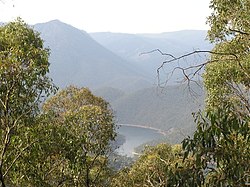| Talbingo Dam | |
|---|---|
 Talbingo Dam in 2005 | |
Location of the Talbingo Dam in New South Wales | |
| Country | Australia |
| Location | Snowy Mountains, New South Wales |
| Coordinates | 35°36′54″S148°18′04″E / 35.61500°S 148.30111°E |
| Status | Operational |
| Construction began | 1968 |
| Opening date | 1971 |
| Owner | Snowy Hydro |
| Dam and spillways | |
| Type of dam | Embankment dam |
| Impounds | Tumut River |
| Height | 162 metres (531 ft) |
| Length | 701 metres (2,300 ft) |
| Dam volume | 14.488 million cubic metres (511.6×106 cu ft) |
| Spillways | 1 |
| Spillway type | Concrete chute |
| Spillway capacity | 4,290 cubic metres per second (151,000 cu ft/s) |
| Reservoir | |
| Creates | Talbingo Reservoir |
| Total capacity | 921,400 megalitres (32,540×106 cu ft) |
| Catchment area | 1,093 square kilometres (422 sq mi) |
| Surface area | 1,935.5 hectares (4,783 acres) |
| Maximum water depth | 110 metres (360 ft) |
| Power Station | |
| Operator | Snowy Hydro |
| Commission date | 1973 |
| Type | Pumped-storage |
| Hydraulic head | 150.9 metres (495 ft) |
| Turbines | 6 |
| Installed capacity | 1,800 megawatts (2,400,000 hp) |
| Website www.snowyhydro.com.au | |
Talbingo Dam is a major ungated rock fill with clay core embankment dam with concrete chute spillway across the Tumut River upstream of Talbingo in the Snowy Mountains region of New South Wales, Australia. The impounded reservoir is called Talbingo Reservoir.

